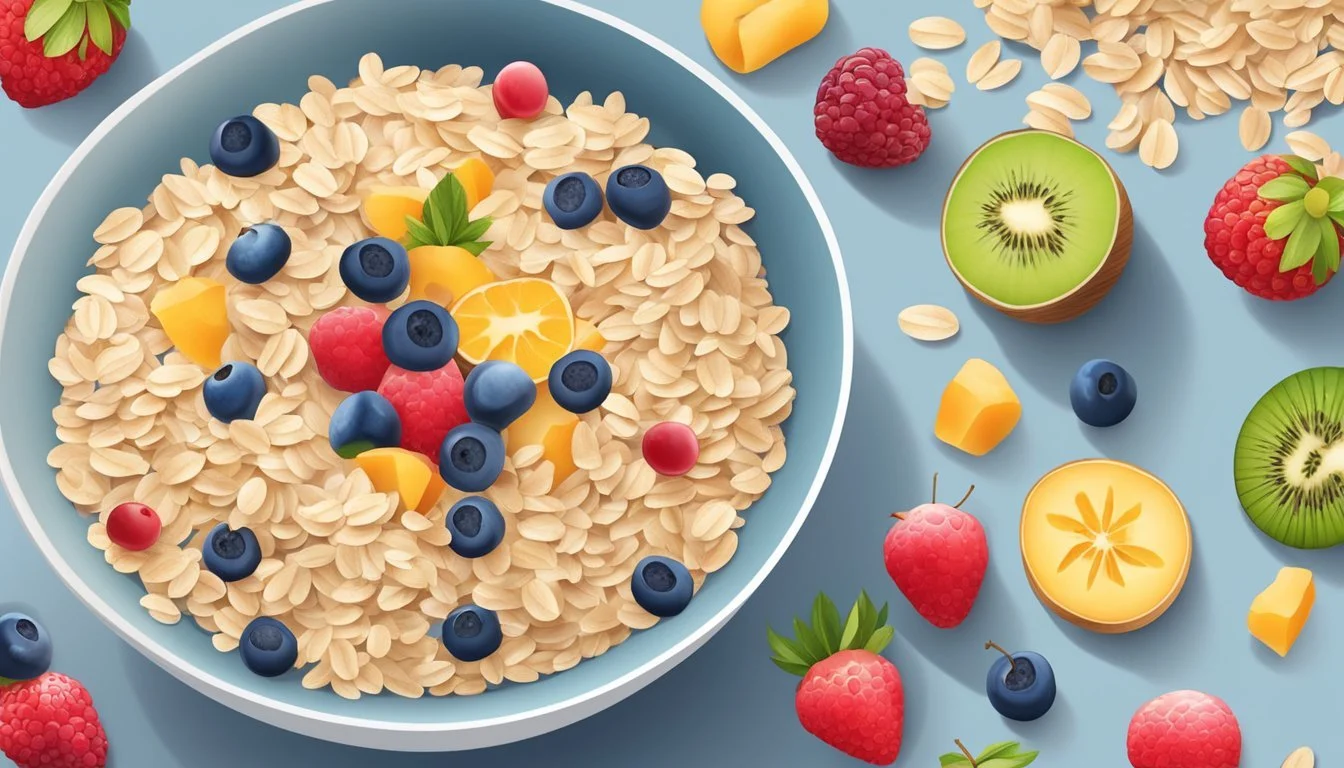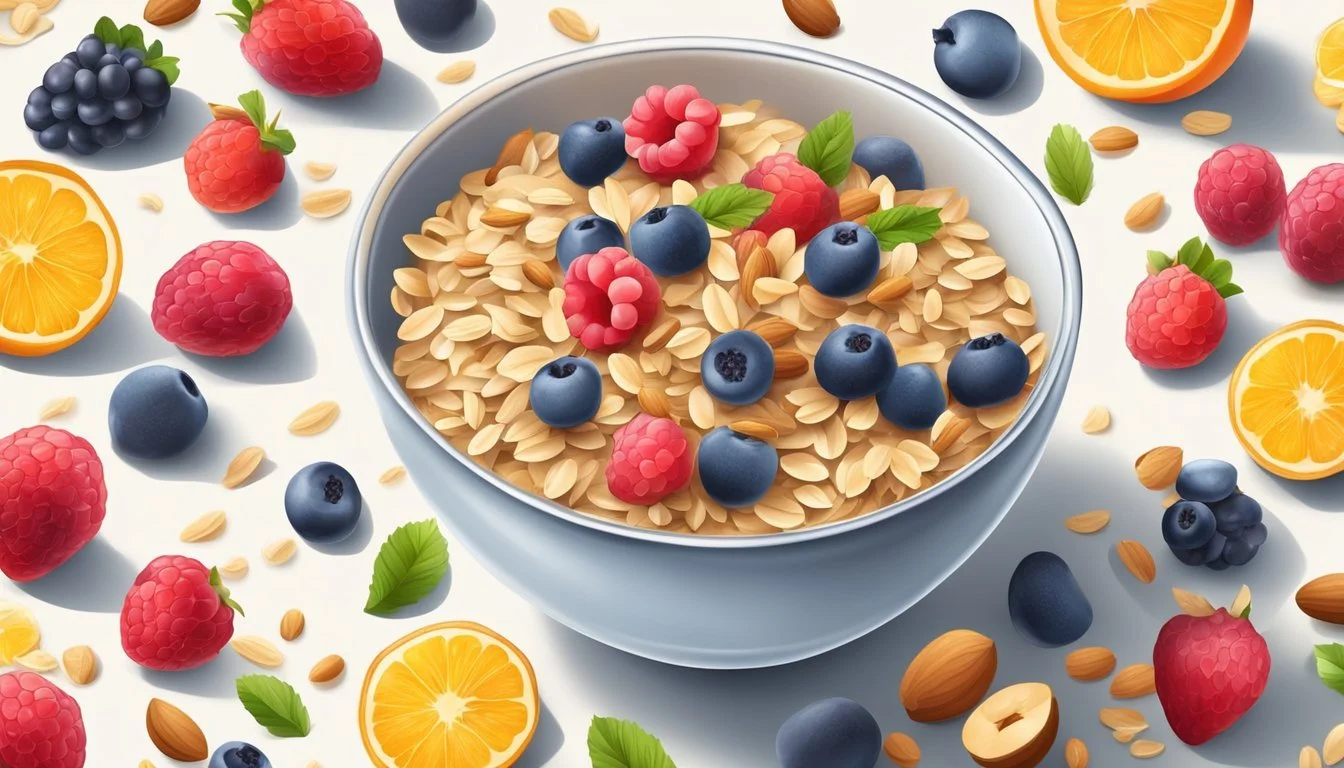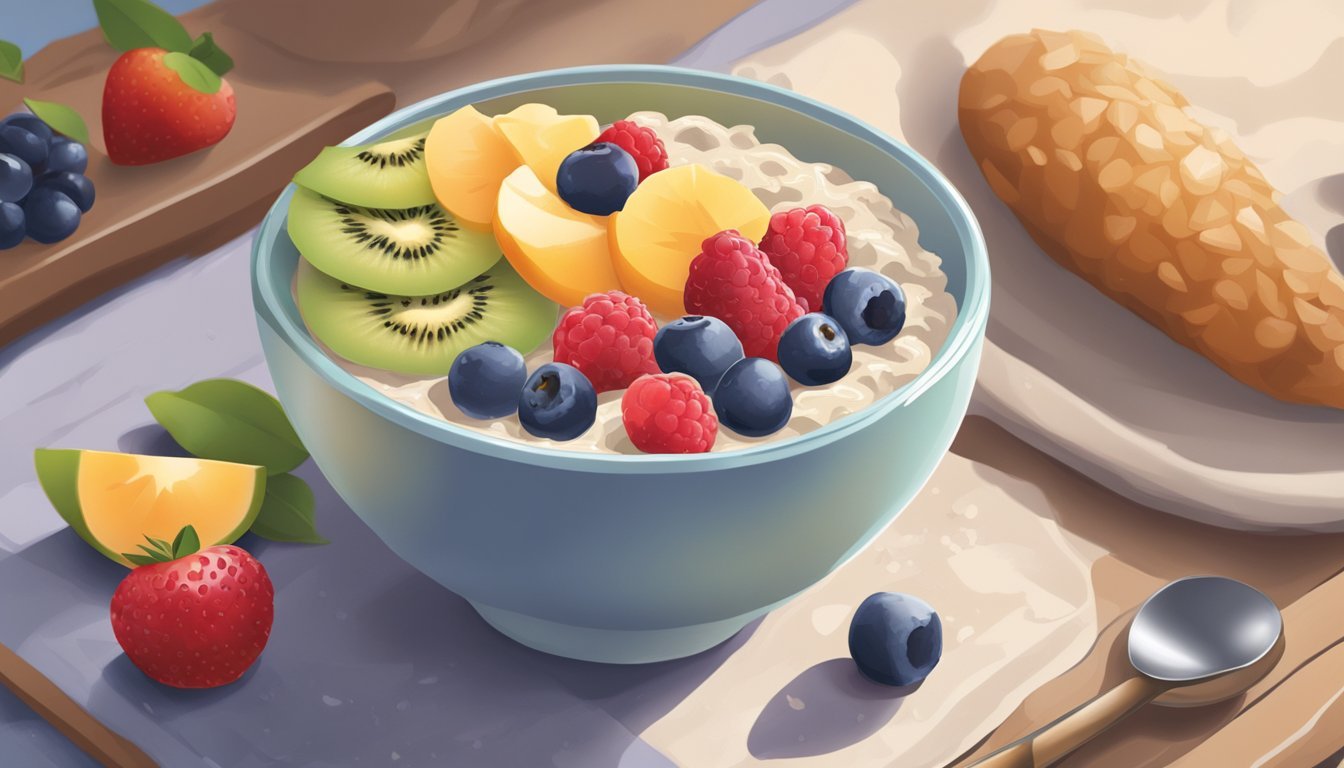Fresh vs. Frozen Fruit: Perfecting Your Overnight Oats Recipe
Overnight oats have become a popular breakfast choice for those seeking a quick and nutritious morning meal. One key ingredient that can elevate this simple dish is fruit. Both fresh and frozen fruit can be successfully used in overnight oats, each offering unique benefits.
Fresh fruit provides a vibrant flavor and crisp texture, while frozen fruit offers convenience and year-round availability. Frozen berries, mangoes, and pineapple chunks are particularly well-suited for overnight oats. When using frozen fruit, it's important to reduce the amount of liquid in the recipe to achieve the desired consistency.
Overnight oats with fruit are easy to prepare and can be customized to personal taste preferences. This healthy breakfast option combines the nutritional benefits of oats with the vitamins and antioxidants found in fruit. Whether using fresh or frozen, adding fruit to overnight oats creates a delicious and satisfying meal to start the day.
Choosing Your Oats
Selecting the right oats is crucial for creating delicious overnight oats. The type of oats you choose impacts texture, cooking time, and nutritional profile.
Types of Oats to Use
Rolled oats, also known as old-fashioned oats, are the most common choice for overnight oats. They absorb liquid well and create a creamy texture. Quick oats work too but may become mushier.
Steel-cut oats can be used but require longer soaking time. They offer a chewier texture and nuttier flavor. Instant oats are not recommended as they become too soft.
Whole oats, or groats, are the least processed option. They need extra soaking time but provide maximum nutrition and a hearty texture.
Rolled vs. Steel-Cut vs. Quick Oats
Rolled oats are flat and absorb liquid quickly, making them ideal for overnight soaking. They create a smooth, creamy consistency.
Steel-cut oats are chopped whole oats. They take longer to soften and maintain a chewy texture. For overnight oats, soak them for at least 10-12 hours.
Quick oats are pre-cooked and rolled thinner. They absorb liquid rapidly but can become mushy. Use less liquid if choosing quick oats.
Gluten-Free and Whole Oat Options
Oats are naturally gluten-free but may be contaminated during processing. Look for certified gluten-free oats if you have celiac disease or gluten sensitivity.
Whole oats, or oat groats, offer the highest nutritional value. They contain more fiber and protein than processed varieties. Soak whole oats for 12-24 hours for the best results.
Some brands offer sprouted oats, which may be easier to digest. These can be used in overnight oats recipes but may require less liquid due to pre-soaking.
Selecting Fruits for Your Overnight Oats
Choosing the right fruits for overnight oats can significantly enhance flavor, texture, and nutritional value. Both fresh and frozen options offer unique benefits, and combining them can create delicious results.
Advantages of Using Fresh Fruit
Fresh fruits provide vibrant flavors and textures to overnight oats. Bananas add natural sweetness and creaminess when mashed into the oat mixture. Sliced strawberries or diced peaches offer juicy bursts of flavor. Fresh berries like blueberries or raspberries maintain their firm texture, creating pleasant pops of flavor in each bite.
Fresh fruits also contribute higher levels of certain vitamins and antioxidants compared to their frozen counterparts. For example, fresh strawberries contain more vitamin C than frozen ones.
Using fresh fruit allows for attractive layering and presentation, especially when preparing oats in clear jars or glasses.
Benefits of Frozen Fruit in Overnight Oats
Frozen fruits offer convenience and year-round availability. They're pre-washed and pre-cut, saving preparation time. Frozen berries, mango chunks, and pineapple pieces work particularly well in overnight oats.
When placed on top of the oat mixture, frozen fruits slowly thaw overnight, releasing their juices and natural sweetness into the oats. This process creates a flavorful, slightly saucy texture.
Frozen fruits can help keep overnight oats cold, ideal for warm summer mornings. They also tend to be more budget-friendly and have a longer shelf life than fresh fruits.
Combining Fresh and Frozen Varieties
Mixing fresh and frozen fruits in overnight oats offers the best of both worlds. Try layering fresh banana slices with frozen mixed berries for a colorful and flavorful combination.
Use frozen fruits as a base layer, then top with fresh fruits just before serving. This method preserves the texture of delicate fresh fruits while benefiting from the convenience of frozen options.
Experiment with seasonal combinations. In summer, pair fresh peaches with frozen blueberries. In winter, combine fresh apple slices with frozen cherries for a comforting blend.
Consider texture when mixing fresh and frozen fruits. Soft fresh fruits like mango pair well with firmer frozen fruits like strawberries, creating an interesting mouthfeel.
Liquid Ingredients and Their Ratios
Choosing the right liquid ingredients and their proportions is crucial for achieving the perfect texture and flavor in overnight oats. The liquid base forms the foundation of this breakfast dish, allowing the oats to soften and absorb flavors overnight.
Milk and Its Alternatives
Dairy milk is a classic choice for overnight oats, providing a creamy texture and rich flavor. The standard ratio is 1:1 oats to milk. For a 1/2 cup of oats, use 1/2 cup of milk. Plant-based alternatives like almond milk, oat milk, or soy milk work equally well. These options cater to different dietary needs and taste preferences.
Almond milk adds a subtle nutty flavor, while oat milk complements the oats' natural taste. For a thicker consistency, reduce the liquid slightly. For a thinner texture, increase the amount of milk or milk alternative.
Water as a Substitute
Water can be used as a liquid base for overnight oats, offering a lighter option. The ratio remains 1:1 when using water. This choice results in a less creamy texture but allows the natural flavor of the oats to shine through.
Water is ideal for those watching their calorie intake or seeking a simpler preparation. It's also a good option when planning to add other flavorful ingredients like mashed banana or nut butter.
Incorporating Yogurt for Texture
Yogurt adds creaminess and tanginess to overnight oats. Greek yogurt, in particular, provides a thick, protein-rich base. When using yogurt, adjust the liquid ratio to maintain the desired consistency. A common combination is 1/4 cup milk, 1/4 cup yogurt, and 1/2 cup oats.
Plant-based yogurts offer similar benefits for those avoiding dairy. Coconut yogurt imparts a tropical flavor, while almond yogurt complements nutty add-ins. Experiment with different yogurt types to find the perfect balance of taste and texture.
Enhancing Flavor and Nutrition
Overnight oats offer a versatile canvas for boosting both taste and nutritional value. Careful selection of sweeteners, seeds, nuts, and protein sources can transform a simple bowl into a nutrient-dense and delicious meal.
Optimal Use of Sweeteners
Maple syrup, honey, and agave syrup are popular natural sweeteners for overnight oats. Maple syrup adds a rich, earthy flavor and contains minerals like manganese and zinc. Honey provides antibacterial properties and a distinct sweetness. Agave syrup offers a low glycemic index option.
For balanced sweetness, start with 1-2 teaspoons per serving. Adjust to taste preferences. Fruit can also provide natural sweetness, reducing the need for added sweeteners.
Including Seeds and Nuts
Chia seeds, hemp seeds, and flax seeds boost the nutritional profile of overnight oats. Chia seeds absorb liquid, creating a pudding-like texture while providing omega-3 fatty acids and fiber. Hemp seeds offer complete protein and a nutty flavor. Ground flax seeds supply lignans and omega-3s.
Add 1-2 tablespoons of seeds per serving. Nuts like almonds, walnuts, or pecans contribute healthy fats and satisfying crunch. Chopped or sliced nuts work best for even distribution throughout the oats.
Protein Additions
Increasing protein content helps create a more filling breakfast. Protein powder is a convenient option, with whey, pea, or rice variants available. Add 1/2 to 1 scoop per serving, adjusting liquid as needed.
Nut butters like peanut butter or almond butter provide protein along with healthy fats. Stir in 1-2 tablespoons per serving. Greek yogurt offers a creamy texture and protein boost. Use it to replace part of the liquid in the recipe.
For a savory twist, add a soft-boiled egg just before serving. This adds protein and creates a more diverse flavor profile.
Texture and Consistency Adjustments
The texture and consistency of overnight oats can be customized to individual preferences. Achieving the perfect balance often involves adjusting liquid ratios and incorporating thickening or thinning agents.
Achieving Your Desired Thickness
For thicker oats, reduce the amount of liquid used. Start with a 1:1 ratio of oats to liquid, then adjust as needed. Adding chia seeds can significantly thicken the mixture, as they absorb liquid and expand overnight.
To thin out oats that have become too thick, simply stir in additional milk or yogurt before eating. This allows for easy adjustments to reach the desired consistency.
When using frozen fruit, the moisture released as it thaws can affect thickness. Account for this by slightly reducing the initial liquid amount.
Use of Thickeners and Thinning Agents
Chia seeds are a popular thickening agent for overnight oats. They add a pleasant texture and boost nutritional value. Start with 1-2 teaspoons per serving and adjust to preference.
Greek yogurt can create a creamier texture while also thickening the oats. For a thinner consistency, use regular milk or plant-based alternatives.
Mashed banana acts as a natural thickener and sweetener. It creates a smoother texture and adds flavor to the oatmeal.
For immediate thinning, warm liquids like milk or water can be stirred in just before eating. This quickly adjusts consistency without changing the overall flavor profile.
Diverse Flavors and Variations
Overnight oats offer endless possibilities for flavor combinations using both fresh and frozen fruits. Mixing different fruits, spices, and add-ins creates unique taste profiles to suit various preferences and moods.
Tropical and Berry Mixes
Tropical fruit blends bring a taste of paradise to overnight oats. Mango and pineapple chunks pair well with coconut flakes for a refreshing flavor. Frozen mixed berries offer convenience and vibrant color.
For a classic berry mix, combine strawberries, blueberries, and raspberries. This antioxidant-rich blend provides a sweet-tart taste. Add a splash of vanilla extract to enhance the fruity flavors.
Peach and blueberry is another delicious combination. The soft sweetness of peaches complements the subtle tartness of blueberries. A sprinkle of cinnamon adds warmth to this fruity duo.
Chocolate and Nutty Blends
Chocolate lovers can indulge in cocoa-infused overnight oats. Mix in cocoa powder and top with sliced bananas for a healthier twist on chocolate banana bread. Frozen cherries pair excellently with chocolate for a Black Forest-inspired treat.
Nutty flavors add depth and crunch. Combine almond butter with sliced apples and a dash of cinnamon. Peanut butter and banana is a classic combination that works well in overnight oats.
For a rich flavor, try hazelnut spread with frozen raspberries. The creamy, chocolatey spread balances the tart fruit. Add chopped hazelnuts for extra texture and nuttiness.
Seasonal and Exotic Combos
Seasonal fruits offer variety throughout the year. In autumn, mix pumpkin puree with frozen cranberries and pumpkin pie spice. For winter, try frozen persimmons with a hint of nutmeg.
Spring calls for fresh strawberries and rhubarb, while summer beckons with juicy peaches and blackberries. These seasonal combos keep overnight oats exciting year-round.
Exotic fruits add adventure to breakfast. Frozen dragon fruit creates a vibrant pink hue and mild sweetness. Passion fruit pulp provides a tangy tropical flavor. Lychee and coconut offer a unique Asian-inspired blend.
Special Dietary Considerations
Overnight oats can be adapted to meet various dietary needs and preferences. By choosing appropriate ingredients and making simple substitutions, this versatile dish can accommodate vegan, allergen-free, and low-sugar diets.
Vegan and Plant-Based Options
For vegan overnight oats, replace dairy milk with plant-based alternatives. Almond, soy, oat, or coconut milk work well. Use plant-based yogurts made from coconut, almond, or soy for added creaminess.
Chia seeds or ground flaxseeds can boost protein and omega-3 content. Sweeteners like maple syrup or agave nectar are vegan-friendly options. Fresh or frozen fruits add natural sweetness and flavor.
Plant-based protein powders can increase protein content. Nuts, seeds, and nut butters provide healthy fats and additional protein.
Managing Allergies and Intolerances
For nut allergies, use seed butters like sunflower or pumpkin seed butter. Coconut milk or rice milk are suitable alternatives to nut milks.
Gluten-free certified oats ensure safety for those with celiac disease or gluten sensitivity. Quinoa flakes or buckwheat groats can replace oats entirely.
For dairy intolerances, use lactose-free milk or plant-based alternatives. Coconut yogurt or dairy-free yogurt substitutes work well.
Avoid certain fruits if allergic. Berries, citrus fruits, or stone fruits can be replaced with tropical fruits like mango or papaya.
Low-Sugar and Diabetic-Friendly Recipes
Use unsweetened plant-based milk to reduce sugar content. Opt for plain, unsweetened yogurt instead of flavored varieties.
Choose low-glycemic fruits like berries, apples, or pears. Frozen fruits without added sugars are excellent options.
Add cinnamon or vanilla extract for natural sweetness without sugar. Stevia or monk fruit sweetener can be used in small amounts.
Increase fiber content with chia seeds, flaxseeds, or psyllium husk. This helps slow sugar absorption.
Incorporate protein sources like Greek yogurt or protein powder to balance blood sugar levels. Nuts and seeds add healthy fats and protein.
Overnight Oats Preparation and Storage
Preparing overnight oats is simple and efficient. Proper storage techniques ensure freshness for several days. Make-ahead strategies save time and simplify busy mornings.
Step-by-Step Instructions
Choose a container: Mason jars or airtight containers work well.
Add 1/2 cup rolled oats to the container.
Pour in 1/2 cup milk or plant-based alternative.
Add 1/4 cup yogurt for creaminess (optional).
Mix in 1-2 tablespoons of chia seeds or other mix-ins.
Add 1/4 cup frozen fruit of choice.
Stir all ingredients thoroughly.
Seal the container and refrigerate overnight or for at least 3 hours.
In the morning, give the oats a quick stir. Add toppings like fresh fruit, nuts, or honey if desired.
Best Storage Practices
Store prepared overnight oats in the refrigerator. Use airtight containers to maintain freshness and prevent absorption of other food odors. Glass mason jars are ideal as they don't retain flavors or odors.
Keep oats refrigerated at all times when not consuming. Properly stored overnight oats last up to 5 days in the fridge. Check for signs of spoilage before eating if stored for more than 3 days.
Avoid freezing prepared overnight oats, as the texture may change upon thawing.
Make-Ahead Tips
Prepare multiple servings at once for efficient meal prep. Create an assembly line with jars and ingredients for quick preparation.
Mix dry ingredients (oats, chia seeds, spices) in advance and store in separate containers. Add wet ingredients and frozen fruit the night before eating.
Portion frozen fruit into small bags or containers for easy addition to oats. This saves time and ensures consistent amounts in each serving.
For variety, prepare different flavors in separate jars. Label each jar with contents and preparation date for easy tracking.
Nutritional Information and Health Benefits
Overnight oats with fruit provide a nutrient-dense breakfast option rich in fiber, vitamins, and minerals. The combination offers a balanced mix of carbohydrates, protein, and healthy fats to fuel your day.
Caloric Contents and Nutritional Balance
A typical serving of overnight oats with fruit contains 300-400 calories. The oats provide complex carbohydrates and protein, while fruit adds natural sugars and micronutrients. A half-cup of rolled oats contains about 150 calories, 5 grams of protein, and 4 grams of fiber.
Fresh or frozen fruit contributes 50-100 calories per serving, depending on the type and amount used. Berries are lower in calories and higher in fiber compared to tropical fruits like mango or pineapple.
Nutrient breakdown per serving:
Protein: 10-15g
Fiber: 7-10g
Calcium: 200-300mg
Iron: 2-3mg
Vitamin C: 15-30% of daily value (from fruit)
Benefits of Fiber and Healthy Fats
Overnight oats are an excellent source of soluble and insoluble fiber. Soluble fiber helps lower cholesterol and regulate blood sugar levels, while insoluble fiber aids digestion and promotes feelings of fullness.
Adding chia seeds or flaxseeds boosts the fiber content and introduces healthy omega-3 fatty acids. These fats support heart health and reduce inflammation. A tablespoon of chia seeds provides:
5g of fiber
2.5g of omega-3 fatty acids
3g of protein
Fruit contributes additional fiber and antioxidants. Berries are particularly high in polyphenols, which may help protect against chronic diseases. The combination of fiber from oats and fruit promotes gut health and supports a healthy microbiome.
Additional Tips and Tricks
Mastering overnight oats involves more than just mixing ingredients. Attention to presentation and customization can elevate this simple breakfast to new heights.
Layering Ingredients for Visual Appeal
Create visually striking overnight oats by layering ingredients. Start with a base of oats and milk, then add colorful layers of fruit, yogurt, and toppings. Use clear jars to showcase the layers. Alternate frozen and fresh fruits for varied textures and colors. Try layering frozen berries, sliced bananas, and a sprinkle of granola for crunch. For a tropical twist, layer frozen mango chunks with coconut flakes. This method not only looks appealing but also allows for easy customization of each bite.
Adjusting Recipes to Personal Taste
Tailor overnight oats recipes to suit individual preferences. Experiment with different milk types - almond, oat, or coconut milk can add unique flavors. Adjust sweetness by varying the amount of honey, maple syrup, or using mashed ripe bananas. For added protein, mix in Greek yogurt or protein powder. Boost nutrition with chia seeds, flax seeds, or hemp hearts. Try different spice combinations like cinnamon, nutmeg, or cardamom. For texture variety, add chopped nuts or seeds just before eating to maintain crunchiness. Don't be afraid to mix and match fruits - combining frozen berries with fresh apples can create interesting flavor profiles.










